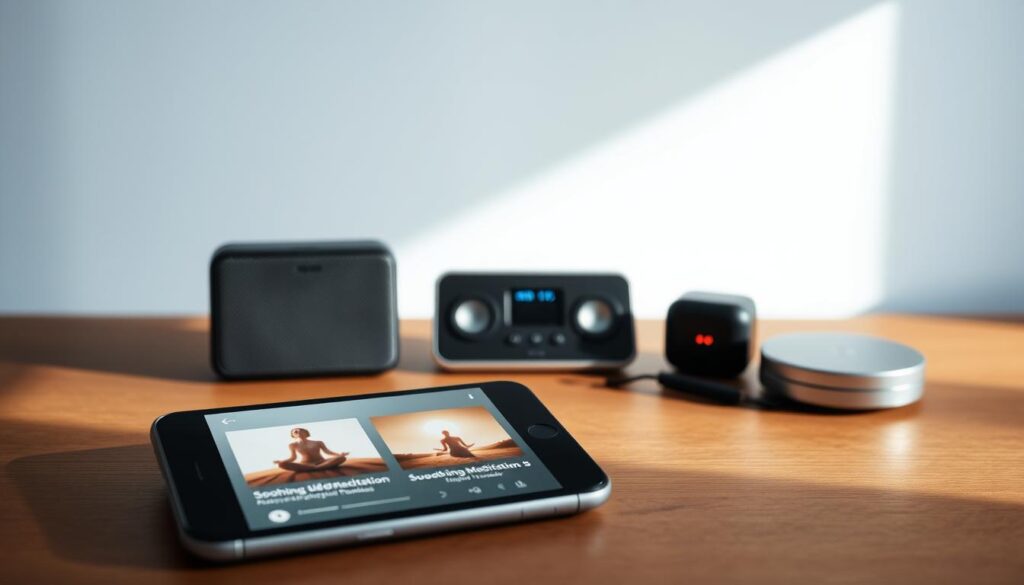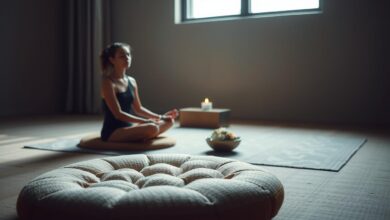Guided Meditation for Anxiety Relief: Find Calm & Clarity

Imagine this: Your mind racing at 2 a.m., or your chest feeling tight during a busy day. Anxiety doesn’t follow a schedule, but you can meet it with a tool that fits yours. Millions use guided meditation for anxiety to quiet their minds. You might have tried apps like Headspace or Calm but weren’t sure where to start.
Or maybe you’ve wondered if meditation could really help with your struggles. This article is for you—a place where science, simplicity, and support meet.
Key Takeaways
- Guided meditation for anxiety offers structured practices to ease stress and improve focus.
- Apps like Insight Timer and Calm provide accessible anxiety relief meditation sessions.
- Regular practice can reduce physical symptoms like rapid heartbeat or tension.
- No prior experience is needed—sessions guide you step by step.
- Combining breathwork and mindfulness creates a toolkit for daily challenges.
This article explains how guided meditation works, why it’s important, and how to start. Let’s make finding calm a journey you can follow—one breath, one moment at a time.
Understanding Anxiety: Causes and Symptoms
Anxiety is more than just stress. It’s a complex way your body protects you. While some worry is okay, too much can mess up your day. Knowing where it comes from and how to spot it helps you take charge. This can be through changing your lifestyle or using anxiety relief meditation.
What is Anxiety?
Anxiety is your brain’s way of warning you about dangers. It releases stress hormones like cortisol. But, when this fear doesn’t go away, it becomes a problem.
Unlike normal stress, anxiety disorders make you feel scared even when there’s no danger. This is different from the usual stress we feel.
Common Causes of Anxiety
- Environmental stress: Work pressure or unstable relationships
- Genetic factors: Family history of anxiety
- Brain chemistry: Imbalances in neurotransmitters like serotonin
- Life events: Trauma, major life changes, or chronic illness
Recognizing Symptoms of Anxiety
Anxiety affects your mind and body. Mental signs include:
- Constant worry about minor or imagined problems
- Racing thoughts that feel hard to stop
Physical symptoms might include:
- Rapid heartbeat or sweating
- Muscle tension or headaches
- Stomachaches or digestive issues
If these symptoms feel too much, meditation to ease anxious thoughts can help. Spotting these signs is the first step to managing them better.
The Power of Meditation for Anxiety Relief
Guided meditation for anxiety is more than just feeling calm. It’s backed by science and changes how your brain deals with stress. Let’s dive into how this ancient practice changes your mind and body.
How Meditation Impacts the Mind
Think of your brain as a garden. Anxiety can let fear grow out of control. But meditation helps plant new, positive thoughts. Regular practice calms the amygdala (your brain’s fear center) and strengthens the prefrontal cortex, which is about logic. This creates new paths in your brain, replacing panic with clarity.
Scientific Benefits of Guided Meditation
Studies show real changes. For example:
- A 2018 JAMA study found 60% of participants saw reduced anxiety after 8 weeks of guided meditation.
- Regular practice lowers cortisol (the stress hormone) by up to 25%, per a Harvard study.
- Relaxation techniques for anxiety also drop blood pressure, easing physical symptoms like rapid heartbeat.
“Meditation isn’t about stopping thoughts—it’s about changing how you relate to them.” — Dr. Sara Lazar, Neuroscientist
These changes aren’t just temporary. Regular practice builds resilience, making it easier to handle daily stress. Ready to start? Next, we’ll explore the best types of guided meditation for you.
Types of Guided Meditation for Anxiety
Not all meditation is the same. There are four evidence-backed methods to fight anxiety. Each one offers a unique way to find calm. So, you can choose what fits your needs best.
Mindfulness Meditation
This practice helps you stay in the present. It teaches you to notice thoughts without getting caught up in them. When anxiety hits, mindfulness keeps you grounded by focusing on your breath or senses.
It’s about letting worries go, like clouds in the sky. You don’t fight them; you just let them pass.
Loving-Kindness Meditation
This method builds compassion, starting with yourself. You repeat phrases like may I find peace. It replaces harsh self-criticism with kindness.
This breaks the cycle of negative thoughts that can fuel anxiety.
Body Scan Meditation
This technique starts at your toes and moves up. It helps you notice and release tension in your body. This can be in your shoulders or chest.
By relaxing these areas, you can break anxiety’s physical hold.
Visualization Meditation
Visualization uses vivid images to create mental safe places. Imagine a quiet beach or a forest clearing. These mental escapes offer instant calm during panic attacks.
They give you a mental pause button.
“Visualization meditation isn’t escapism—it’s brain training. It teaches your nervous system to recognize safety cues,” explains Dr. Sarah Taylor, UCLA anxiety specialist.
How to Get Started with Guided Meditation
Starting meditation can seem hard, but taking small steps helps a lot. Let’s look at how to pick the right tools and set up a space for calm.
Choosing the Right Apps and Resources
Start by checking out apps like Headspace or Calm. They have guided anxiety meditation audio for stress. You can also try free options like Insight Timer and Meditation Minis on YouTube. Look for sessions that fit your needs, like adjustable lengths or themes for anxiety.
- Free trials: Try apps before paying.
- Audio focus: Choose apps with great guided anxiety meditation audio.
- Community support: Check for forums or guided courses within apps.

Creating a Comfortable Space for Meditation
Find a quiet spot to sit comfortably. You can use a cushion, chair, or even your bed. What’s most important is being consistent. Soft lights or candles can help set a calm mood. A room that’s not too hot or cold is also key for focus.
“Your meditation space doesn’t need to be perfect—it just needs to feel like yours.”
Here are some tips:
- Turn off your phone or use “Do Not Disturb” mode.
- Add plants or scents like lavender to help you focus.
- Begin with 5-minute sessions to build confidence.
It’s not about being perfect. Even 10 minutes a day with the right guided anxiety meditation audio can help. Your journey starts now.
Establishing a Meditation Routine
Building a consistent practice is key to experiencing the full benefits of anxiety relief meditation. Small, regular sessions create lasting mental resilience—here’s how to make it work for you.
Finding the Best Time to Meditate
Timing matters. Try these options to align your practice with your anxiety patterns:
- Mornings: Start your day calm with a 5-minute guided meditation for anxiety to set intentions.
- Midday breaks: Use lunchtime sessions to reset during stressful hours.
- Evenings: Release tension before bed to improve sleep quality.
Tips for Consistency and Commitment
Make meditation a habit with these actionable steps:
- Start tiny: Begin with 2–3 minutes daily—short sessions build momentum.
- Anchor it to routines: Pair meditation with brushing your teeth or drinking morning coffee.
- Track progress: Use apps like Headspace or Insight Timer to monitor streaks and celebrate milestones.
- Adjust expectations: Progress isn’t linear. Even 10 seconds of focus counts—kindness toward yourself keeps you going.
A 2022 study in the Journal of Clinical Psychology found that 85% of participants maintained their practice when pairing meditation with existing habits.
Remember: Regularity trumps duration. Even brief daily sessions create lasting mental shifts. Your consistency today plants seeds for calm tomorrow.
Deep Breathing Techniques in Guided Meditation
Learning to control your breath is essential for calming your mind. Two effective breathe and release anxiety meditation methods can change how you deal with stress. Let’s dive into these simple yet powerful relaxation techniques for anxiety to help your body and mind relax.
Diaphragmatic Breathing
- Place one hand on your chest and the other on your belly.
- Inhale deeply through your nose, letting your lower hand rise while keeping your upper hand steady.
- Exhale slowly through pursed lips, focusing on your belly falling. Aim for 5–10 minutes daily to activate your body’s calm response.
Tip: Start by lying down to feel the breath fully in your diaphragm. Avoid shallow chest breathing—it can make stress worse.
Box Breathing Method
This method, used by Navy SEALs, helps balance your nervous system. Follow these four equal steps:
- Inhale for 4 counts.
- Hold for 4 counts.
- Exhale for 4 counts.
- Hold empty lungs for 4 counts. Repeat 5 times.
“Box breathing lowers cortisol levels in 2–3 minutes, making it ideal for panic moments.”
Try these techniques during breaks or before stressful tasks. Even 2 minutes of focused breathing can reset your mental state. Use guided audio apps like Insight Timer or Calm for extra support. Remember: consistency builds confidence—practice daily to see lasting results.
Incorporating Mindfulness Into Daily Life
Mindfulness for anxiety isn’t just for meditation. You can make daily routines mindful. This brings calm into every moment. Even small pauses can help you stay present and calm.
Practicing Mindfulness at Work
Office stress can be reduced with these simple steps:
- 3-Minute Breathing Break: Close your eyes and focus on slow breathing. It resets your nervous system quickly.
- Mindful Email Checks: Pause before answering emails. Notice the physical act of typing. It stops anxiety.
- Desk Stretches with Awareness: Stretch while focusing on the sensations. It shifts your mind to the present.
Mindful Commutes and Everyday Activities
Make routines mindful with these steps:
- Walking Meditation: Pay attention to each step. Let thoughts drift by like clouds.
- Mealtime Focus: Eat slowly, noticing flavors and textures. It stops stress eating.
- Chores as Meditation: Do chores mindfully, like washing dishes. It grounds you.
Every mindful moment builds strength. By adopting these practices, you turn daily life into a mindfulness journey. It’s a constant path to anxiety relief.
Overcoming Common Obstacles in Meditation
Learning to meditate isn’t always easy, thanks to anxiety. We’ll tackle two big challenges: dealing with distracting thoughts and staying motivated when progress is slow.

Dealing with Distracting Thoughts
It’s normal for thoughts to wander during calming meditation for stress. Here’s how to handle it:
- Label thoughts as “planning,” “worry,” or “memory” to acknowledge them without judgment.
- Return gently to your breath or guided audio, like a guided anxiety meditation audio, to reset focus.
- For persistent thoughts, write them down briefly after your session to address them later.
Staying Motivated in Your Practice
Progress isn’t always fast, but small changes are important. Notice how you feel after meditating. Try new guided anxiety meditation audio sessions or apps like Calm or Headspace for inspiration. Join online groups like Insight Timer’s community to share your journey. Focus on being consistent, not perfect.
“Anxiety tries to say you’re failing. Meditation teaches you to observe, not engage.”
Every moment you sit in meditation is valuable. Even five minutes a day can help you grow stronger. Adjust your practice as needed—it’s yours to explore.
Personal Success Stories from Guided Meditation
Learn how meditation has changed lives for the better. Real stories and expert tips show how to fight anxiety.
Testimonials on Meditation for Anxiety
Many have found peace with guided visualization for anxiety. A teacher from Colorado says, “Meditation helped me calm down fast.” Others like the breathe and release anxiety meditation for letting go of stress. They all say it takes time—most saw changes in 4-6 weeks.
“The first month felt tough, but sticking with visualization turned my anxiety from a daily battle into an occasional challenge.”
Expert Insights and Recommendations
Experts say meditation is best with regular practice. Here’s what they recommend:
| Tip | Why It Works |
|---|---|
| Start with 5-10 minute sessions | Builds routine without overwhelm |
| Use apps like Insight Timer | Access guided sessions anytime |
| Combine with therapy | Strengthens overall mental health |
Dr. Lena Torres, a neuroscientist, says, “The brain gets better at calm with regular meditation.” Whether it’s breathe and release anxiety meditation or visualization, success comes with patience and effort.
Resources for Further Exploration
Building a lasting practice needs tools and community. These resources help deepen your meditation and mindfulness journey. Find what suits your style and needs.
Books on Meditation and Anxiety
The Anxiety and Phobia Workbook by Edmund Bourne mixes cognitive-behavioral strategies with meditation. Jon Kabat-Zinn’s Full Catastrophe Living teaches mindfulness for anxiety with daily exercises. For a modern view, check out Wherever You Go, There You Are, a classic meditation guide.
Online Courses and Workshops
Coursera’s “Mindfulness for Well-Being” offers free courses on calming thoughts. Calm and Insight Timer have guided sessions for anxiety. Udemy’s “Mastering Mindfulness” teaches meditations for anxious thoughts through breath and visualization.
Support Groups and Communities
Meetup and the Anxiety and Depression Association of America (ADAA). org offer local and online groups. Reddit’s r/Mindfulness and Facebook groups are great for sharing and asking. Apps like What’s App or Zoom host live sessions with experts.




